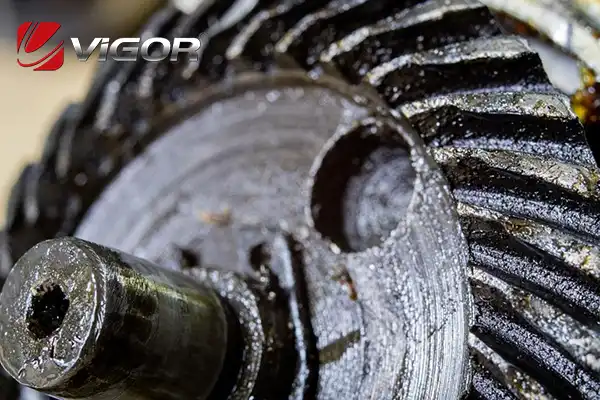
Knowledge
The Failure Forms of Transmission Gears Mainly Include the Following Types
Tooth Breakage
Under the repeated action of alternating loads, the tooth root is subjected to significant bending stress. When this stress exceeds the limit that the material can withstand, tiny cracks will form at the tooth root. Over time, these cracks will gradually expand, eventually leading to fatigue breakage of the tooth. Additionally, sudden breakage may occur when the gear is subjected to short-term overload or sudden impact loads. To prevent tooth breakage, several measures can be taken: Firstly, through reasonable design and material selection, the bending stress at the tooth root can be limited. Secondly, the geometry and dimensions of the gear can be optimized to reduce stress concentration at the tooth root. Thirdly, the tooth root can be strengthened through processes such as shot peening or rolling to enhance its fatigue resistance. Finally, scientific heat treatment processes can be employed to ensure that the mechanical properties of the gear material are at their best.
Pitting on Tooth Surfaces
Pitting on tooth surfaces is one of the common failure forms in gear transmission. When the tooth surfaces are subjected to repeated alternating loads, and the contact stress exceeds the allowable limit of the material, tiny cracks will gradually form on the surface. These cracks will continuously expand under continuous stress, eventually leading to the shedding of small metal particles and the formation of pits. The occurrence of pitting not only damages the integrity of the tooth surface but also causes vibration and noise in the gear transmission, seriously affecting the smoothness and service life of the transmission. To prevent pitting on tooth surfaces, the following measures can be taken: Firstly, through reasonable design and material selection, limit the contact stress on the tooth surface; secondly, increase the hardness of the tooth surface to enhance its fatigue resistance; thirdly, reduce the roughness value of the tooth surface to minimize the possibility of stress concentration; finally, use lubricating oil with higher viscosity to form an effective lubricating film and reduce the chance of direct metal contact.
Tooth Surface Wear
Tooth surface wear is an inevitable failure mode in gear transmission, mainly including abrasive wear and adhesive wear. Abrasive wear occurs when hard particles (such as sand grains, iron filings, etc.) enter the meshing surface of gears and cause cutting and scraping on the tooth surface during relative motion, leading to gradual material loss. Adhesive wear, on the other hand, results from the relative sliding between tooth surfaces in addition to rolling contact during gear meshing, which causes gradual material wear due to sliding friction. To mitigate tooth surface wear, the following measures can be taken: Firstly, increase the hardness of the tooth surface to enhance its wear resistance; secondly, reduce the roughness value of the tooth surface to lower the friction coefficient; thirdly, improve the working environment to minimize the intrusion of hard particles; finally, add an appropriate amount of anti-wear agents to the lubricating oil and keep it clean to form an effective lubricating film and reduce wear.
Tooth Surface Scuffing
In high-speed and heavy-load gear transmission, the pressure between tooth surfaces is extremely high, and the relative sliding speed is also very high. Under such circumstances, the heat generated by friction can cause a sharp increase in the temperature of the meshing area, leading to the failure of lubricating oil and direct contact and adhesion of the tooth surface metals. As the tooth surfaces move relatively, the softer tooth surface metal will be torn off from the surface, resulting in adhesive wear. This phenomenon is called tooth surface scuffing. Tooth surface scuffing not only aggravates the wear of gears but also leads to a decrease in transmission efficiency and may even cause serious faults. To prevent tooth surface scuffing, the following measures can be taken: Firstly, increase the hardness of the tooth surface to enhance its anti-scuffing ability; secondly, select lubricating oil with higher viscosity or good anti-scuffing performance to form an effective lubricating film; thirdly, reduce the roughness value of the tooth surface to decrease the generation of frictional heat; finally, adopt design methods such as positive modification gears, reducing the module and lowering the tooth height to decrease the sliding speed of the tooth surface and reduce the risk of scuffing.
Plastic Deformation of Tooth Surfaces
Under heavy loads, especially for gears made of soft steel or other relatively soft materials, the tooth surfaces may undergo plastic deformation due to insufficient yield strength. This deformation can cause the tooth surfaces to lose their original correct tooth profile, leading to poor gear meshing, reduced transmission accuracy, and even gear failure. To prevent plastic deformation of the tooth surfaces, the following measures can be taken: Firstly, ensure good lubrication conditions to reduce the friction force between the tooth surfaces; secondly, lower the roughness value of the tooth surfaces to reduce stress concentration; thirdly, select materials with higher yield strength to enhance the tooth surfaces' resistance to deformation; finally, optimize the design and manufacturing process of the gears to improve their overall strength and rigidity, thereby resisting plastic deformation under heavy loads.
Welcome to contact us for more detailed information, please feel free to contact us at info@castings-forgings or call us at 0086 81127932




